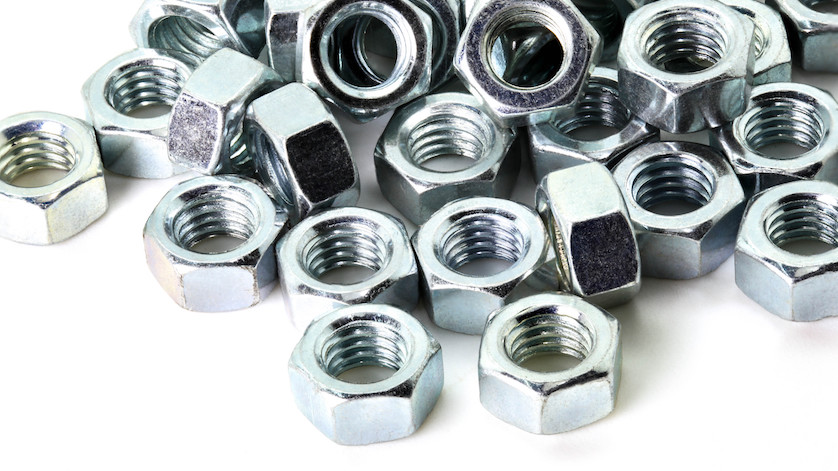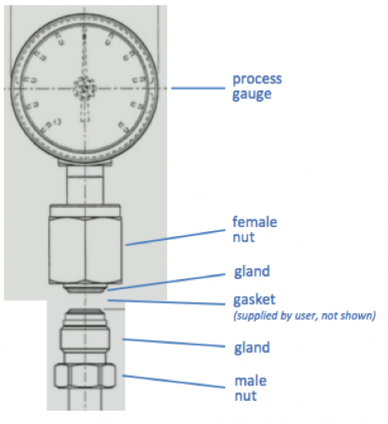
Fittings that flake silver are a major concern in ultra-high purity (UHP) processes. That’s why WIKA has developed gall-resistant nuts made of UNS S21800 stainless steel, a chromium–iron alloy with inherent lubricity and self-mating characteristics to reduce the risk of cross-threading and seized fittings.
Several customers in the semiconductor industry have approached WIKA pressure specialists with concerns about process connectors that flake silver, and whether gall-resistant fittings would solve the issue. Here are some of their most commonly asked questions, and our answers.

Face seal process connector
Q: I’m a little confused about terminology. Are the terms process connector, fitting, gland, face seal, and nut used interchangeably, or are there differences?
A: Good question. Basically, a pressure sensor needs a process connector in order to safely attach it to the application and to measure its pressure. Process connectors are a specific type of fitting, and many people in the process industry – including the engineers at WIKA – use the two terms interchangeably.
WIKA products come in a variety of process connectors, such as face seals, modular surface mounts, and weld stubs. The connector typically used in UHP (ultra-high purity) applications is the face seal. This is a metallically sealing fitting where two toroidal (doughnut)-shaped geometries (tubes), called glands, are tightened against each other over a metal gasket. A pair of nuts, one female and one male, tightens the two glands together.
Q: Why doesn’t WIKA refer to its process connectors as “VCR”?
A: VCR® is a trademark and is specific to one manufacturer of process connectors. WIKA uses general industry terms that are applicable to all manufacturers of such fittings.
Q: I’ve been hearing about a shift to a new standard of nuts. What is behind this change?
A: Let’s first talk about the metals used in fittings. Nuts are made of corrosion-resistant stainless steel. These materials, however, tend to gall over time. Galling occurs when two metals repeatedly rub against each other without sufficient lubrication, which forms tiny nicks and/or bumps that cause the threads to eventually stick to one another. Silver offers good protection against galling, which is why many threads are plated with silver.
However, we’ve observed in the field that in face seals, the silver-plating of the female nut tended to flake after repeated tightening and loosening, thus increasing the risk of contaminating the application. That’s why WIKA developed nuts made of UNS S21800 stainless steel, a chromium–iron alloy. Its inherent lubricity and self-mating characteristics reduce the risk of cross-threading and seized fittings. Therefore, the new standard of nuts – the gall-resistant fitting – is to prevent the silver flaking that would contaminate process media in UHP processes.
Q: Who makes your gall-free fittings?
A: These new standard nuts are manufactured to WIKA’s own specifications and material designation. We either make our own parts using in-house machining capabilities, or ship to stock approved external workbenches. Note: Only the nuts of face-seal fittings are made of gall-resistant UNS S21800 stainless steel.
Q: What do SEMI standards say about the material compatibility of your non-galling stainless steel, especially with regard to corrosive media?
A: SEMI (Semiconductor Equipment and Materials International) standards go into great detail about the material and surface properties of wetted system components in UHP media. These wetted components are things such as tubing, glands, and media-guiding parts. UNS S21800 nuts are parts that hold together the fitting glands of face-seal process connectors. As such, these nuts are non-wetted parts, which means SEMI standards do not have much to say about them. That being said, compared to 316L stainless steel, UNS S21800 stainless steel has equal or better stability in aggressive environments.
Q: Are WIKA fittings in strict compliance with SEMI specifications?
A: Yes and no. Let us explain. First, many customers have heard about SEMI specifications, but these are actually guidelines. In other words, while they are useful recommendations for the entire chip-manufacturing industry, they are not requirements that suppliers and users have to follow strictly. Second, many manufacturers – including WIKA – look to these SEMI guidelines when designing products. In those cases, the product specs and datasheets will explicitly mention adherence to SEMI guidelines.
Q: Where can I find the applicable SEMI guidelines?
A: Please see the SEMI website for more information.
Q: Are there any difference between “UNS S21800,” “Gall-Tough,” and “Nitronic 60”?
A: UNS S21800 is the Unified Numbering System designation for a high-performance stainless steel made of iron, chromium, manganese, nickel, silicon, nitrogen, and carbon. UNS S21800 is the term used by ASTM, ASEM, and ASM. Another name for this hardened austenitic stainless steel is Alloy 218.
Nitronic 60® is AK Steel Holding Corporation’s trademarked name for UNS S21800. Gall-Tough® is Carpenter Technology’s trademarked name for another gall-resistant stainless steel, UNS S20161.
Q: How does UNS S21800 compare with other stainless steels when it comes to corrosion resistance in process connections?
A: There are many different types of stainless steel, and UNS S21800 is simply one of them. The definition of stainless steel is an iron alloy with at least 10.5% chromium. As we all know, iron rusts. The greater the percentage of chromium, the better the stainless steel is able to withstand the formation of ferric oxide (rust).
Both UNS S21800 and the commonly used 316L stainless steel have roughly the same percentage of chromium, making them equally rust resistant. However, UNS S21800’s higher contents of manganese and silicon make this alloy more resistant to wear and galling.
| UNS S21800 | 316L |
|---|---|---|
chromium | 16–18% | 16-18% |
manganese | 7–9% | 0–2% |
molybdenum | 0–0.75% | 2–3% |
nickel | 8–9%% | 10–14% |
silicon | 3.5–4.5% | 0–0.75% |
nitrogen | 0.08–0.18% | 0–0.1% |
carbon | 0–0.1% | 0–0.030% |
iron | 59.1–65.4% | 62–72% |
Q: What is the maximum pressure of the gall-resistant nut?
A: 11,200 psi. UNS S21800 has similar or superior mechanical properties compared to 316L.
Q: What is the best way to tighten gall-resistant nuts?
A: Finger-tighten the connection first, and then use a wrench to give it another quarter turn.
Q: Could I buy just these nuts, as a single part?
A: Sorry, but the UNS S21800 gall-resistant nut is a component of WIKA products and, therefore, not available for individual sale.
Q: Does WIKA use UNS S21800 for both male and female process connectors?
A: Currently, UNS S21800 is an option for both types. Starting January 1, 2021, UNS S21800 will become standard for the female face-seal process connector and remain an option for the male face-seal process connector.
Q: Why isn’t the UNS S21800 female process connector silver-plated?
A: Because there’s no need. Silver plating does increase certain metals’ ability to resist galling, but UNS S21800 is already gall resistant. What’s more, silver plating can flake into the process stream, thereby contaminating the process stream.
Q: Are UNS S21800 process connectors suitable for corrosive gases?
A: Absolutely. UNS S21800 is a stainless steel with excellent corrosion resistance.
Q: Who else is buying UNS S21800 process connectors? Can you give me a customer list as a reference?
A: WIKA respects the privacy of all our distributors, integrators, OEMs, and end users. As such, we do not release any information that our partners and customers would consider proprietary or confidential.
Q: How can I find out more information about the new fitting parts?
A: For drawings and more details about WIKA’s UNS S21800 nuts, please contact our specialists in pressure measurement for the semiconductor industry. They would be happy to discuss with you the best options for your specific applications.


The blog is well writem.
thanks for info